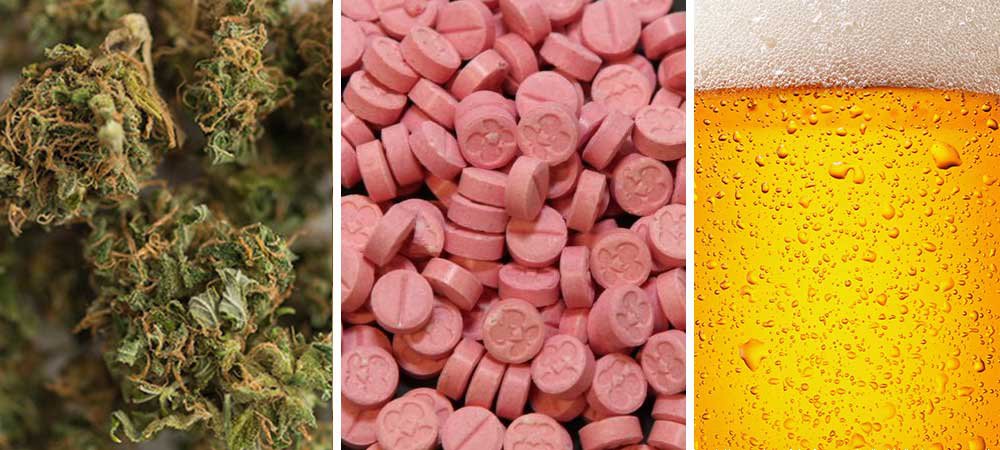Polydrug use
What is polydrug use?
‘Polydrug use’ is a term for the use of more than one drug or type of drug at the same time or one after another.1 Polydrug use can involve both illicit drugs and legal substances, such as alcohol and medications.
Other names
Multiple drug use, multiple substance use

Reasons for mixing drugs
There are many reasons people mix drugs, this might include:
- to ‘bring’ on or enhance the desired effects of one drug, such as drinking alcohol while using stimulants
- to stop or decrease the negative effects of a drug, such as using depressants like cannabis or benzodiazepines to reduce the impact of coming down from stimulants
- substituting a drug of choice for an alternative; for example, being unable to access heroin and substituting it with alcohol and cannabis instead
- when a person is intoxicated by alcohol or other drugs and they take another drug without thinking about or considering the effects
- to reduce dependence on one drug by using a combination of others.2
Effects of polydrug use
There is no safe level of drug use. Use of any drug always carries some risk. It is important to be careful when taking any type of drug.
Polydrug use may affect everyone differently, based on:
- size, weight and health
- whether the person is used to taking the combination of drugs
- the amounts taken
- the strength of the drugs (varies from batch to batch for each illegally produced drug)
- if alcohol or medications are consumed as well.
It is difficult to predict the effects of one drug, but it is even harder to predict the effects of multiple drugs.
Taking multiple drugs of the same class (such as two stimulants) increases the impact on the brain and body and overdose can occur.3
Effects become even more complicated to predict if different classes of drugs are taken. For example, taking a stimulant with a depressant.3
Any drugs taken in combination increase the risk of harm.
Mixing stimulants
When different stimulants are taken at the same time, such as cocaine and ice, the possibility of heart problems increases. Combining stimulants also increases the risk of psychosis, anxiety, or panic attacks. The likelihood of experiencing serotonin syndrome is also increased.3
Serotonin syndrome
Serotonin is a hormone found in the brain that controls our mood, feelings of well-being and happiness.4 Serotonin syndrome is a harmful drug reaction caused by too much serotonin and is often linked to MDMA, methamphetamine and cocaine. It can be fatal.
Mild side effects can include:
- mental confusion
- hyperactivity
- muscular problems.5
More serious side effects can include:
- fever and sweating
- rapid heartbeat
- muscle spasms5
- death.
Mixing depressants
Depressant drugs slow down the activity of the central nervous system and reduce breathing rate.
When two or more depressants are combined there is an increased risk of:
- accidents or injury
- impaired judgement and coordination
- vomiting
- irregular or shallow breathing
- blackouts and memory loss
- unconsciousness
- coma
- death.6
Mixing depressants and stimulants
If stimulants are mixed with depressants the body is placed under a lot of stress as it tries to deal with the competing effects.
For example, when methamphetamine is combined with alcohol the heart experiences greater strain. This can lead to dangerous complications, particularly for someone with a heart condition.
Other effects of combining depressants and stimulants include:
- heart problems
- respiratory infections and bronchitis
- dehydration, overheating, and kidney failure.3
Mixing medications
Mixing medications, either prescribed or over-the-counter, with other drugs can have negative effects.
Combining benzodiazepines with opioids can lead to a decreased breathing rate and an increased risk of overdose.7
Some pharmaceutical drugs, such as strong pain relievers, antidepressants, anticonvulsants, anti-psychotics, some antihistamines and over-the-counter medications, can have an adverse effect when taken with benzodiazepines, leading to breathing difficulties and an increased risk of overdose and death.8
The use of benzodiazepines to help with the comedown effects of stimulant drugs (such as amphetamines or ecstasy) may result in dependence on both types of drug.
Mixing different medications can also have negative effects. If you have concerns about taking medications, or drinking alcohol with medication, you should consult a health professional.
Mixing alcohol
Alcohol interacts with many drugs including medications, over-the-counter medicines and illegal drugs.9
Mixing alcohol and medicines can be harmful.
Alcohol and some medications can make you tired, drowsy, or lightheaded. When mixing alcohol and medication the effects can be intensified.10
Other effects of mixing alcohol and medication include:
- difficulty concentrating
- inability to perform simple tasks
- risk of falls and injuries (especially in older people).9
Mixing alcohol with illegal drugs can have various effects depending on the type of drug.
Alcohol can increase the risk of drowsiness when mixed with other depressant drugs such as GHB or heroin. This can lead to overdose.3
Mixing alcohol with cocaine produces a chemical called cocaethylene, which is toxic and is associated with seizures, liver damage, and compromised immune system.11
Overdose and polydrug use
In Australia, many fatal drug overdoses are caused by mixing drugs.
A recent report by the Australian Bureau of Statistics found that multiple drugs were found in over half (59%) of unintentional drug overdoses. It is rare for an overdose to be from a single drug.
Polydrug deaths involving four or more substances have increased significantly in recent years.12
Path2Help
Not sure what you are looking for?
Try our intuitive Path2Help tool and be matched with support information and services tailored to you.

- World Health Organization. Lexicon of alcohol and drug terms 2021 [cited: 19.03.2021].
- European Monitoring Centre for Drugs and Drug Addiction. Poly Drug Use: Patterns and Responses 2009 19.03.2021.
- Black E. Polydrug use: What you need to know about mixing drugs. In: National Drug and Alcohol Research Centre UoNSW, editor. 2014.
- Network HH. Serotonin Hormone Health Network 2018 [cited: 22.03.2021].
- Darke S, Lappin J, Farrell M. The Clinician's Guide to Illicit Drugs. United Kingdom: Silverback Publishing 2019.
- Brands B, Sproule B, Marshman J. Drugs & Drug Abuse. 3rd ed. Ontario: Addiction Research Foundation; 1998.
- Abuse NIoD. Benzodiazepines and Opioids 2021 [cited: 24.03.2021].
- Guina J, Merrill B. Benzodiazepines : Upping the Care on Downers: The Evidence of Risks, Benefits and Alternatives. Jorunal of Clinical Medicine. 2018;17(7).
- te hiringa hauora Health Promotion Agency. Alcohol effects Interactions with other drugs n.d. [cited: 26.03.2021].
- National Institute on Alcohol Abuse and Alcoholism. Harmful Interactions Mixing Alcohol with Medicines 2014 [cited: 26.03/2021].
- Dasgupta A. Alcohol, Drugs, Genes and the Clinical Laboratory An Overview for Healthcare and Safety Professionals: Elsevier Inc; 2017.
- Pennington Institute. Australia's Annual Overdose Report Melbourne 2020.

